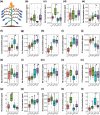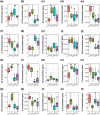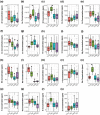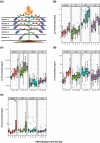Heat stress changes mineral nutrient concentrations in Chenopodium quinoa seed
- PMID: 35146239
- PMCID: PMC8818816
- DOI: 10.1002/pld3.384
Heat stress changes mineral nutrient concentrations in Chenopodium quinoa seed
Abstract
Quinoa is a popular seed crop, often consumed for its high nutritional quality. We studied how heat stress in the roots or the shoots of quinoa plants affected the concentrations of 20 elements (aluminum, arsenic, boron, calcium, cadmium, cobalt, copper, iron, potassium, magnesium, manganese, molybdenum, sodium, nickel, phosphorous, rubidium, sulfur, selenium, strontium, and zinc) in quinoa seed. Elemental concentrations in quinoa seed were significantly changed after an 11-day heat treatment during anthesis. The type of panicle (main, secondary, and tertiary) sampled and the type of heat treatment (root only, shoot only, or whole plants) significantly affected elemental profiles in quinoa seed. Plants were also divided into five sections from top to bottom to assess the effect of panicle position on seed elemental profiles. Plant section had an effect on the concentrations of arsenic, iron, and sodium under control conditions and on copper with heat treatment. Overall, the time of panicle development in relation to the time of heat exposure had the largest effect on seed elemental concentrations. Interestingly, the quinoa plants were exposed to heat only during anthesis of the main panicle, but the elemental concentrations of seeds produced after heat treatment ended were still significantly changed, indicating that heat stress has long-lasting effects on quinoa plants. These findings demonstrate how the nutritional quality of quinoa seeds can be changed significantly even by relatively short heat spells.
Keywords: elemental profile; heat; ionomics; nutrient composition; quinoa; seed.
© 2022 The Authors. Plant Direct published by American Society of Plant Biologists and the Society for Experimental Biology and John Wiley & Sons Ltd.
Conflict of interest statement
The authors declare that they have no conflicts of interest.
Figures






Similar articles
-
Seed priming with selenium improves growth and yield of quinoa plants suffering drought.Sci Rep. 2024 Jan 9;14(1):886. doi: 10.1038/s41598-024-51371-6. Sci Rep. 2024. PMID: 38195846 Free PMC article.
-
Heating quinoa shoots results in yield loss by inhibiting fruit production and delaying maturity.Plant J. 2020 Jun;102(5):1058-1073. doi: 10.1111/tpj.14699. Epub 2020 Feb 24. Plant J. 2020. PMID: 31971639 Free PMC article.
-
Changes in Quinoa Seed Fatty Acid Profile Under Heat Stress Field Conditions.Front Nutr. 2022 Mar 28;9:820010. doi: 10.3389/fnut.2022.820010. eCollection 2022. Front Nutr. 2022. PMID: 35419388 Free PMC article.
-
Seed Dormancy and Preharvest Sprouting in Quinoa (Chenopodium quinoa Willd.).Plants (Basel). 2021 Feb 28;10(3):458. doi: 10.3390/plants10030458. Plants (Basel). 2021. PMID: 33670959 Free PMC article. Review.
-
Quinoa protein: Composition, structure and functional properties.Food Chem. 2019 Nov 30;299:125161. doi: 10.1016/j.foodchem.2019.125161. Epub 2019 Jul 9. Food Chem. 2019. PMID: 31323439 Review.
Cited by
-
Cotton under heat stress: a comprehensive review of molecular breeding, genomics, and multi-omics strategies.Front Genet. 2025 Mar 18;16:1553406. doi: 10.3389/fgene.2025.1553406. eCollection 2025. Front Genet. 2025. PMID: 40171219 Free PMC article. Review.
-
Changes in the content and accumulation of macroelements in different parts of the quinoa plant biomass Chenopodium quinoa willd.Sci Rep. 2025 Jul 2;15(1):22918. doi: 10.1038/s41598-025-04797-5. Sci Rep. 2025. PMID: 40594185 Free PMC article.
-
Identification of the Dof Gene Family in Quinoa and Its Potential Role in Regulating Flavonoid Synthesis Under Different Stress Conditions.Biology (Basel). 2025 Apr 20;14(4):446. doi: 10.3390/biology14040446. Biology (Basel). 2025. PMID: 40282311 Free PMC article.
-
Effects of Heat Stress on Plant-Nutrient Relations: An Update on Nutrient Uptake, Transport, and Assimilation.Int J Mol Sci. 2023 Oct 27;24(21):15670. doi: 10.3390/ijms242115670. Int J Mol Sci. 2023. PMID: 37958654 Free PMC article. Review.
-
High Growing Temperature Changes Nutritional Value of Broccoli (Brassica oleracea L. convar. botrytis (L.) Alef. var. cymosa Duch.) Seedlings.Foods. 2023 Jan 29;12(3):582. doi: 10.3390/foods12030582. Foods. 2023. PMID: 36766111 Free PMC article.
References
-
- Abuelgasim, A. , & Ammad, R. (2019). Mapping soil salinity in arid and semi‐arid regions using Landsat 8 OLI satellite data. Remote Sensing Applications: Society and Environment, 13, 415–425. 10.1016/j.rsase.2018.12.010 - DOI
-
- Adolf, V. I. , Jacobsen, S.‐E. , & Shabala, S. (2013). Salt tolerance mechanisms in quinoa (Chenopodium quinoa Willd.). Environmental and Experimental Botany, 92, 43–54. 10.1016/j.envexpbot.2012.07.004 - DOI
-
- Aguilar, P. C. , & Jacobsen, S.‐E. (2003). Cultivation of quinoa on the Peruvian Altiplano. Food Review International, 19, 31–41. 10.1081/FRI-120018866 - DOI
-
- Al‐Naggar, A. M. M. , Abd El‐Salam, R. M. , Badran, A. E. E. , & El‐Moghazi, M. M. A. (2017). Drought tolerance of five quinoa (Chenopodium quinoa Willd.) genotypes and its association with other traits under moderate and severe drought stress. Asian Journal of Advances in Agricultural Research, 3, 1–13.
LinkOut - more resources
Full Text Sources

